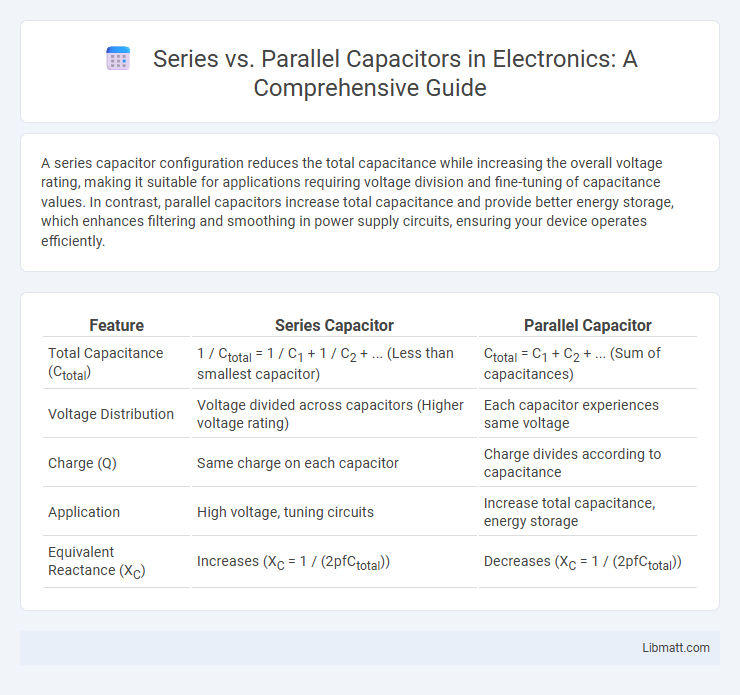A series capacitor configuration reduces the total capacitance while increasing the overall voltage rating, making it suitable for applications requiring voltage division and fine-tuning of capacitance values. In contrast, parallel capacitors increase total capacitance and provide better energy storage, which enhances filtering and smoothing in power supply circuits, ensuring your device operates efficiently.
Table of Comparison
| Feature | Series Capacitor | Parallel Capacitor |
|---|---|---|
| Total Capacitance (Ctotal) | 1 / Ctotal = 1 / C1 + 1 / C2 + ... (Less than smallest capacitor) | Ctotal = C1 + C2 + ... (Sum of capacitances) |
| Voltage Distribution | Voltage divided across capacitors (Higher voltage rating) | Each capacitor experiences same voltage |
| Charge (Q) | Same charge on each capacitor | Charge divides according to capacitance |
| Application | High voltage, tuning circuits | Increase total capacitance, energy storage |
| Equivalent Reactance (XC) | Increases (XC = 1 / (2pfCtotal)) | Decreases (XC = 1 / (2pfCtotal)) |
Introduction to Capacitors
Capacitors store electrical energy by accumulating charge on two conductive plates separated by an insulating material called the dielectric. In series configurations, the total capacitance decreases as the inverse sum of individual capacitances, resulting in higher voltage ratings but lower overall capacitance. Parallel capacitor arrangements increase total capacitance by summing individual capacitances, enhancing charge storage capacity and current supply in electrical circuits.
Understanding Series Capacitor Configuration
A series capacitor configuration connects capacitors end-to-end, causing the total capacitance to decrease and behave inversely to the sum of individual capacitances. This arrangement influences voltage distribution, where the voltage across each capacitor varies depending on its capacitance value. Series capacitors are crucial in applications requiring voltage division, tuning circuits, and managing reactive power in power systems.
Understanding Parallel Capacitor Configuration
In a parallel capacitor configuration, multiple capacitors are connected across the same two nodes, resulting in a total capacitance equal to the sum of all individual capacitances. This setup increases the overall capacitance and maintains the voltage across each capacitor equally. Parallel capacitors are commonly used in filtering applications to stabilize voltage and supply smoother power in electronic circuits.
Key Differences: Series vs Parallel Capacitors
Series capacitors have a total capacitance lower than any individual capacitor, calculated using the reciprocal sum formula, which affects voltage distribution across each component. Parallel capacitors combine their capacitances directly, resulting in a total capacitance equal to the sum of all capacitors, improving charge storage capacity. Understanding these key differences helps optimize your circuit design for desired voltage tolerance and capacitance values.
Capacitance Calculation: Series vs Parallel
Capacitance calculation differs significantly between series and parallel capacitor configurations. In a parallel arrangement, the total capacitance (C_total) is the sum of individual capacitances (C_total = C1 + C2 + ... + Cn), increasing overall capacitance and storing more charge at the same voltage. In series, the reciprocal of total capacitance is the sum of reciprocals (1/C_total = 1/C1 + 1/C2 + ... + 1/Cn), resulting in reduced capacitance and higher voltage tolerance, which is crucial for your electronic circuit design.
Voltage Distribution: Series and Parallel Arrangements
In series capacitor arrangements, voltage divides across each capacitor inversely proportional to their capacitances, resulting in higher voltage stress on smaller capacitors. Parallel capacitor arrangements maintain the same voltage across all capacitors, allowing each to store charge independently while sharing the total stored energy. Voltage distribution in series circuits requires careful consideration of capacitor ratings to prevent breakdown, whereas parallel circuits benefit from uniform voltage exposure, improving overall reliability.
Applications of Series Capacitors
Series capacitors are widely used in power transmission systems to improve voltage stability and control reactive power flow. By compensating for inductive reactance, they enhance power factor and reduce transmission losses in high-voltage lines. You can also find series capacitors in filter circuits, where they help in tuning frequencies and protecting equipment from voltage spikes.
Applications of Parallel Capacitors
Parallel capacitors are commonly used in power supply filters to smooth voltage fluctuations and reduce ripple in DC outputs. They provide increased total capacitance and improve energy storage, essential for stabilizing voltage in electronic circuits such as amplifiers and oscillators. In RF circuits, parallel capacitors enhance frequency tuning and impedance matching, optimizing signal performance and integrity.
Advantages and Disadvantages of Each Configuration
Series capacitors offer the advantage of reduced overall capacitance, making them ideal for tuning circuits and voltage division, but their disadvantage lies in increased equivalent series resistance and potential voltage imbalance. Parallel capacitors provide increased total capacitance and improved current handling capability, which benefits filtering and energy storage applications, yet their main drawback is a larger physical size and higher leakage current. Choosing between series and parallel configurations depends on specific application requirements such as voltage rating, capacitance value, and circuit impedance.
Choosing Between Series and Parallel Capacitor Connections
Choosing between series and parallel capacitor connections depends on the desired total capacitance and voltage rating for the circuit. Series capacitors result in a lower total capacitance but a higher voltage rating, useful for applications requiring voltage division and increased voltage endurance. Parallel capacitors combine their capacitances directly, increasing the total capacitance while maintaining the voltage rating of individual components, ideal for energy storage and filtering functions.
Series vs Parallel Capacitor Infographic

 libmatt.com
libmatt.com